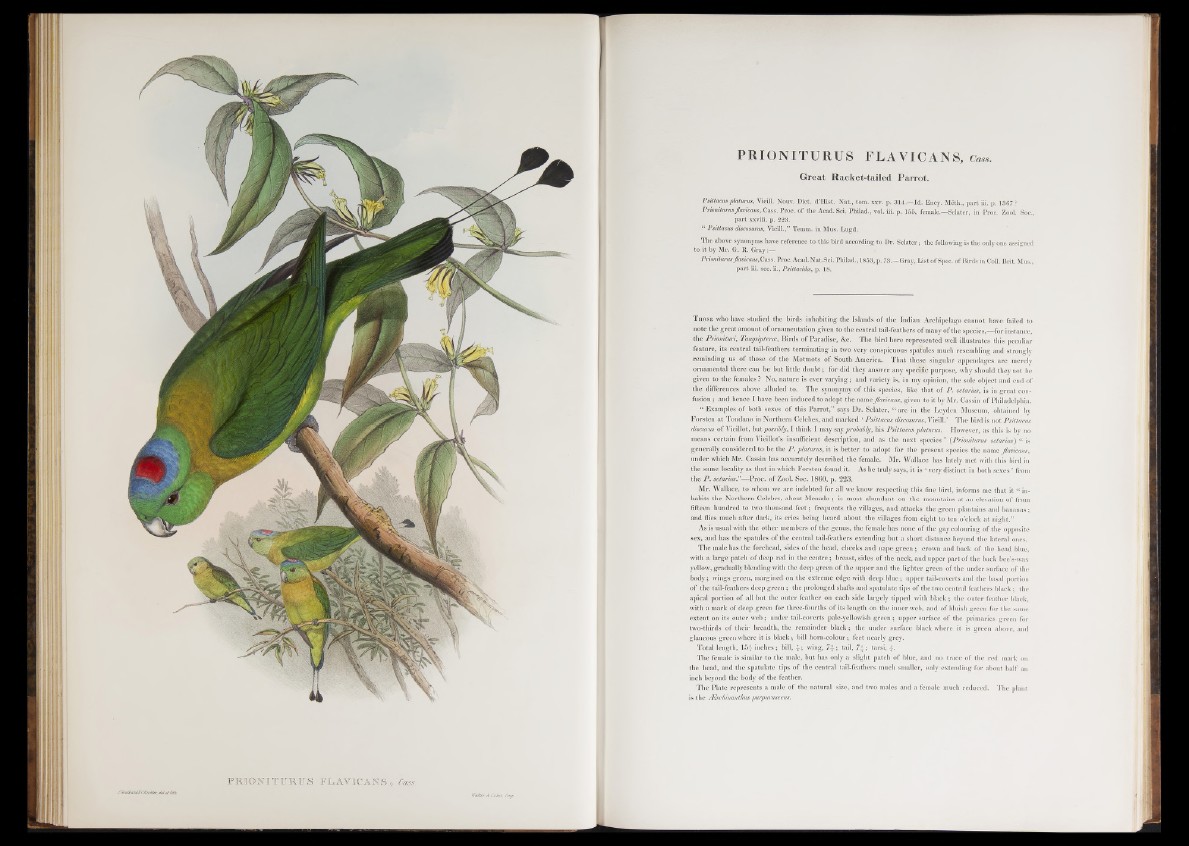
JGcubltmiJ'CRicrtUr, dU tihtk
PW O K IT Ï ÏR U S F L AVI CANS » <êm
PRIONITURUS FLAVICANS, Cass.
Great Racket-tailed Parrot.
Pnttacus platurus, Vieill. Nouv. Diet. d’Hist. Nat., tom. xxv. p. 314.—Id. Ency. Meth., part iii. p. 1367 ?
PrionUurusJImkaiis, Cass. Proc. of the Acad. Sci. Philad., vol. iii. p. 155, female.—Sclater, in Proc. Zool. Soc„
part xxviii. p. 223.
Psittacus discosurus, Vieill.,” Temm. in Mus. Lugd.
The above synonyms have reference to this bird according to Dr. Sclater; the following is the only one assigned
to it by Mr. G. R. Gray:—
Prionitwrus Jlavicans,Cass. Proc. Acad. Nat. Sci. Philad., 1853, p. 73.—Gray, L ist of Spec, o f Birds in Coll. Brit. Mus.,
part iii. sec. ii., Psittacida, p. 18;
T hose who have studied the birds inhabiting the Islands of the Indian Archipelago cannot have failed to
note the great amount o f ornamentation given to the central tail-feathers of many of the species,—for instance,
the Prionituri, Tamysipteroe, Birds of Paradise, &c. The bird here represented well illustrates this peculiar
feature, its central tail-feathers terminating in two very conspicuous spatules much resembling and strongly
reminding. uç of those of the Motmots of South America. That these singular appendages are merely
ornamental there can be but little doubt ; for did they answer any specific purpose, why should they not be
given to the females ? No, nature is ever varying ; and variety is, in my opinion, the sole object and end of
the differences above alluded to. The synonymy of this species, like that of P . setarius, is in great confusion
; and hence I have been induced to adopt the name Jlavicans, given to it by Mr. Cassin of Philadelphia.
" Examples of both sexes of this Parrot,” says Dr. Sclater, “ are in the Leyden Museum, obtained by
Forsten at Tondano in Northern Celebes, and marked ‘ Psittacus discosurus, Vieill.’ The bird is not Psittacus
discwus of Vieillot, but possibly, I think I may say probably, his Psittacus platurus. However, as this is by no
means certain from Vieillot’s insufficient description, and as the next species ” (Prioniturus setarius) “ is
generally considered to be the P . plattirus, it is better to adopt for the present species the name Jlavicans,
under which Mr. Cassin has accurately described the female. Mr. Wallace has lately met witli this bird in
the same locality as that in which Forsten found it. As he truly says, it is ‘ very distinct in both sexes ’ from
the P . setarius.”— Proc. o f Zool. Soc. 1860, p. 223.
Mr. Wallace, to whom we are indebted for all we know respecting this fine bird, informs me that it “ inhabits
the Northern Celebes, about Menado ; is most abundant on the mountains at an elevation o f from
fifteen hundred to two thousand feet ; frequents the villages, and attacks the green plantains and bananas ;
and flies much after dark, its cries being heard about the villages from eight to ten o’clock at night.”
As is usual with the other members of the genus, the female has none of the gay colouring of the opposite
sex, and has the spatules of the central tail-feathers extending but a short distance beyond the lateral ones.
The male has the forehead, sides of the head, cheeks and nape green ; crown and back of the head blue,
with a large patch of deep red in the centre ; breast, sides o f the neck, and upper part of the back bee’s-wax
yellow, gradually blending with the deep green of the upper and the lighter green o f the under surface of the
body; wings green, margined on the extreme edge with deep blue; upper tail-coverts and the basal portion
of the tail-feathers deep green ; the prolonged shafts and spatulate tips of the two central feathers black ; the
apical portion of all but the outer feather on each side largely tipped with black ; the outer feather black,
with a mark of deep green for three-fourths of its length on the inner web, and of bluish green for the same
extent on its outer web; under tail-coverts pale-yellowish green ; upper surface of the primaries green for
two-thirds of their breadth, the remainder black ; the under surface black where it is green above, and
glaucous green where it is black ; bill horn-colour ; feet nearly grey.
Total length, 15-f inches; bill, -J-; wing, 7-f ; tail, 7-f-; tarsi, ■§■.
The female is similar to the male, but has only a slight patch of blue, and no trace of the red mark on
the head, and the spatulate tips of the central tail-feathers much smaller, only extending for about half an
inch beyond the body of the feather.
The Plate represents a male of the natural size, and two males and a female much reduced. The plant
is the Æschinanthus purpurascens.